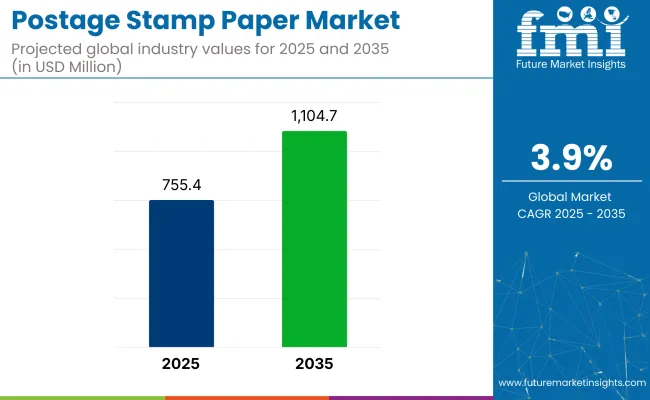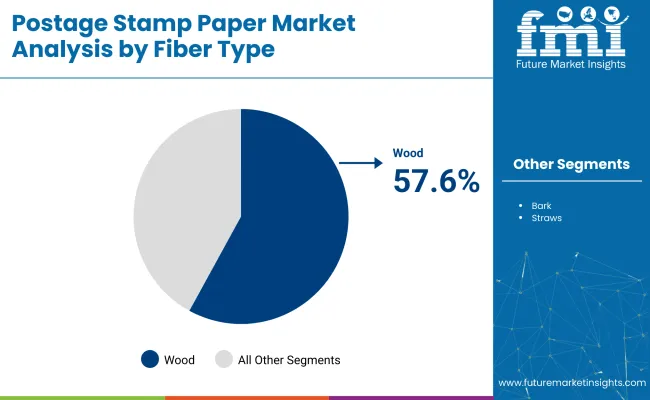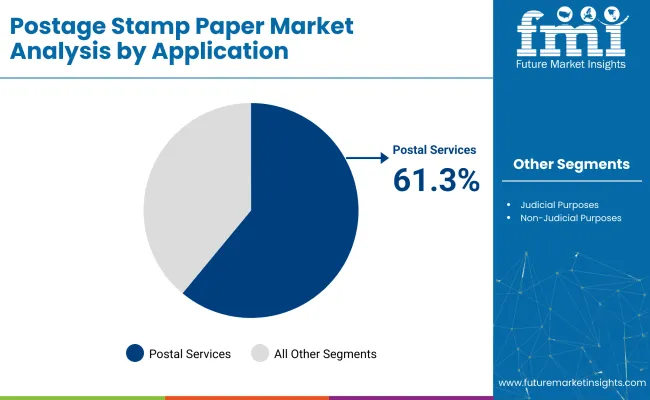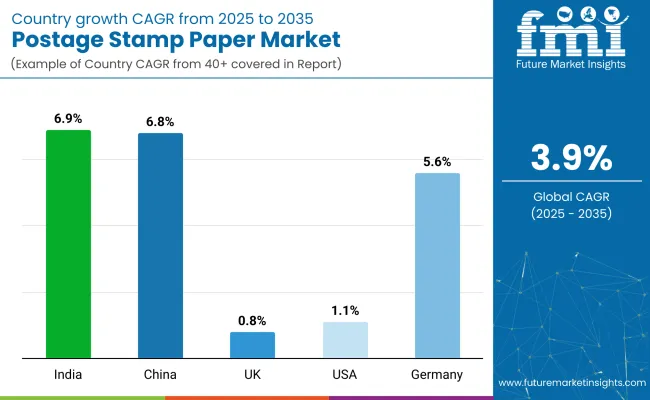The global postage stamp paper market is projected to grow from USD 755.4 million in 2025 to USD 1,104.7 million by 2035, registering a CAGR of 3.9% during the forecast period. Sales in 2024 were recorded at USD 727.2 million.

| Attributes | Description |
|---|---|
| Estimated Global Postage Stamp Paper Market Size (2025E) | USD 755.4 million |
| Projected Global Postage Stamp Paper Market Value (2035F) | USD 1,104.7 million |
| Value-based CAGR (2025 to 2035) | 3.9% |
This growth is primarily attributed to technological advancements in paper production, the evolving demand for secure, durable materials in postal services, and a growing collector base. Postage stamp paper, distinct from ordinary paper, is crafted specifically for the creation of postage stamps, often featuring unique textures and fiber compositions to prevent counterfeiting and ensure longevity.
In April 2023, Authentix, a global leader in authentication and information services, announced the acquisition of Royal Joh. Enschedé, a renowned security printing firm based in Haarlem, Netherlands. This strategic acquisition was aimed at expanding Authentix's capabilities in high-security printing, particularly in the production of postage stamps and banknotes.
"This strategic acquisition expands our portfolio and capabilities in high security printing technologies to support Authentix's ongoing growth in programs for governments, central banks, and commercial brand owners," stated Kevin McKenna, CEO of Authentix. This move is expected to bolster Authentix's position in the postage stamp paper market by integrating centuries of specialized printing knowledge.
Recent innovations in postage stamp paper have led to significant improvements in product functionality and customization. Manufacturers have focused on developing high-quality, secure, and durable paper that caters to the specific needs of various postal authorities and collectors. Advancements in printing technologies have enabled the production of visually appealing and intricate stamp designs, enhancing their philatelic value. Additionally, the integration of security features, such as watermarks and specialized fibers, has improved the authenticity and traceability of postage stamps.
The postage stamp paper market is expected to witness significant growth in emerging economies, particularly in the Asia-Pacific region, due to rapid industrialization and increasing consumer awareness. Applications are expanding beyond traditional postal services, with growing adoption in legal documents and commemorative stamps. Manufacturers are anticipated to focus on developing cost-effective and versatile paper solutions to cater to diverse industry needs and comply with evolving regulatory standards.
The market has been segmented based on fiber type, paper type, application, and region. By fiber type, wood, bark, and straws have been utilized to meet the structural, durability, and texture demands of stamp paper production. Laid, wove, batonne, and glazed paper types have been adopted to achieve specific surface finishes, printability, and security features.
Applications have been divided into judicial purposes, non-judicial purposes, and postal services to reflect usage across administrative and commercial document handling. Regional segmentation has been conducted for North America, Latin America, East Asia, South Asia & Pacific, Western Europe, Eastern Europe, and the Middle East & Africa to capture varying legal frameworks and postal infrastructure developments.

The wood segment is expected to account for the highest share of 57.6% in the postage stamp paper market in 2025, as its use has been supported by strong fiber bonding, high opacity, and compatibility with intaglio and offset printing.
Wood-based papers have been extensively applied in definitive, commemorative, and specialty stamp series requiring durability and fine detail. Color absorption and surface finish have been optimized for vivid imagery and microtext. Paper strength and rigidity have enabled efficient sheet cutting and perforation.
Coating and gum application processes have been effectively integrated with wood pulp substrates to maintain adhesive performance. Resistance to curling and edge wear has improved storage and handling during philatelic distribution. Security features such as embedded fibers and watermarks have been incorporated during papermaking. Continued usage has been reinforced by postal authorities’ reliance on wood-based stock for visual and functional consistency.

The postal services segment is projected to lead the application category with a 61.3% share of the postage stamp paper market in 2025, driven by global mail volumes, regulatory print standards, and ongoing stamp issuance programs.
Stamp paper has been applied for domestic and international mail, government dispatches, and collector editions. High-speed printing, die-cutting, and gumming lines have required uniform sheet quality and dimensional stability. Adhesion reliability and cancellation compatibility have been maintained for efficient postal processing.
Design flexibility for national events, commemorations, and seasonal campaigns has been accommodated through tailored stamp formats. Security enhancements such as UV inks, microprinting, and tactile elements have been supported by the paper’s print surface. Postal agencies have adopted large-scale production batches requiring material consistency and supply reliability. Dominance of this segment has been upheld through institutional procurement and official issuance mandates.
| Product Specification (- Bulk Order (>100k sheets)) | Price Range (USD per 1000 sheets) |
|---|---|
| Basic Security Paper | 70 to 90 USD |
| Enhanced Security Grade | 130 to 160 USD |
| Premium Watermark Paper | 180 to 220 USD |
| RFID-Embedded Security Paper | 350 to 450 USD |
| Collector's Grade | 250 to 350 USD |
| UV-Reactive Special Grade | 200 to 280 USD |
Due to strict security regulations and high-quality standards, postage stamp paper prices vary significantly by region, with North American and European markets asking for higher prices. pricing in Asian countries, such as China and India, are up to 20% less than the advertised wholesale pricing due to economies of scale and reduced production costs.
Because of stricter regulations and a greater need for high-end security features, costs in Europe are typically 10% to 15% more.
Security feature integration significantly impacts pricing, with each added feature increasing the base cost by 8-12%. Advanced papers, such as those with RFID embedding, can see cost increases of up to 200%. Product prices have also increased by 7 to 10% due to the growing expenses of chemical treatments, which have increased by 15% in the last year.
Bulk purchase reductions of 15 to 25% are available through volume-based pricing dynamics, while long-term contracts can offer price stability with yearly increases restricted to 3 to 5%.
Growing E-commerce Shipping
The need for postage stamps and shipping labels has been significantly impacted by the rapid expansion of online retail. Specialized security paper has become more and more necessary as e-commerce continues to grow internationally in order to handle the daily growth in the number of packages being transported.
The need for premium stamp paper is essential to the expansion of the market since e-commerce sites and merchants depend on safe, long-lasting postal service to guarantee accurate delivery and tracking.
Enhanced Security Features Integration
With rising concerns about counterfeit postage, there has been an increasing demand for paper with advanced security features. Watermarks, UV-reactive fibers, microprinting, and other complex features make stamps more difficult to counterfeit.
Postage stamp paper with these improved security features is becoming more and more necessary as postal systems throughout the world prioritize preventing counterfeiting, which is propelling market expansion.
Government Postal Services Modernization
As governments across the world modernize their postal services and introduce automation initiatives, there is a growing need for higher-quality stamp paper that can be integrated with modern printing technologies.
Because of these developments, postage stamp paper needs to be durable and secure enough to withstand advanced printing techniques like digital and high-speed printing. In order to stay up with changing postal operations, this modernization is increasing demand for premium postage stamp paper.
Extension of Cross-Border Trade
Secure and uniform postage documentation is becoming more and more necessary as global trade keeps growing. Reliable and anti-counterfeit stamps are necessary due to the rise in cross-border transactions in order to guarantee accurate customs paperwork and safe international package delivery.
The need for specialist security papers that satisfy international postal and commerce criteria is rising as a result of the increase in global trade activities.
Digital Communication Revolution
Traditional mail and stamp usage have drastically decreased as a result of the broad use of digital communication tools like email and instant messaging. The need for actual postage stamps and postage stamp paper has reduced as more people and companies communicate electronically.
The market for postage stamp paper is severely constrained by this move toward digital communication since it reduces the need for traditional postal services as a whole.
Integration of Smart Paper Technologies
There is a lot of room for creativity when innovative paper technologies, such as RFID or NFC capabilities, are incorporated into postage stamp paper. Postal services can provide improved tracking, authentication, and anti-counterfeit capabilities by including these technologies in stamps.
Manufacturers have the opportunity to create innovative solutions that address convenience and security thanks to this potential for enhanced technology integration, creating new market growth opportunities.
Sustainable Production Methods
As demand for eco-friendly solutions grows, there is a rising opportunity for manufacturers to develop postage stamp paper using sustainable production methods. Postal services and consumers alike are looking for more ecologically friendly solutions that reduce carbon emissions.
To meet consumer needs and global environmental goals, businesses can now innovate with biodegradable materials, recycled fibers, and eco-friendly production methods thanks to this trend toward sustainability.
Hybrid Security Features
The incorporation of many physical, chemical, and digital components into a single stamp paper product is a major development in the postal stamp paper business. These hybrid characteristics offer strong security measures to stop counterfeiting and improve stamp authenticity. The increasing integration of these multi-faceted security elements is setting a new standard in the industry, making it a prominent trend.
Bio-based Security Elements
There is a growing trend toward using natural, biodegradable materials for security features in postage stamp paper while maintaining high-security standards. As the industry moves toward sustainability, bio-based security components like organic dyes and plant-based fabrics are becoming more popular. This trend offers creative solutions to improve the security and environmental friendliness of postage stamp paper while also supporting ecological aims.
Digital-Physical Integration
Combining digital tracking systems with actual stamps is another new development in the postal stamp paper industry. This entails integrating technology that enables physical stamps to be connected to digital databases, such as digital serial numbers and QR codes.
The smooth transition between digital and physical systems makes improved traceability and monitoring possible, which benefits postal services and customers alike by increasing security and convenience.

| Countries | CAGR |
|---|---|
| India | 6.9% |
| China | 6.8% |
| UK | 0.8% |
| USA | 1.1% |
| Germany | 5.6% |
The postage stamp paper market in India is anticipated to develop at a robust compound annual growth rate (CAGR) of 6.9%. A growing interest in philately and the postal service's expanding infrastructure are responsible for this rise. The market will continue to grow as India's commercial and public postal systems develop and grow, increasing demand for safe, superior stamp paper. Furthermore, the need for dependable postal services is being fueled by the rising acceptance of online shopping.
China's postage stamp paper market is expected to grow at a compound annual growth rate (CAGR) of 6.8%. The need for safe postal solutions is greatly increased by the nation's expanding foreign trade and quickly expanding e-commerce industry.
Furthermore, this market expansion is anticipated to be sustained by China's continuous postal system modernization developments and growing consumer interest in collection stamps. The thriving export industry also needs standardized and safe postage for international shipments.
The United Kingdom is expected to experience a modest CAGR of 0.8% in the postage stamp paper market. While the UK maintains a stable demand for postage stamps, the rise of digital communication and electronic postage systems has led to slower growth in traditional postal services.
However, philatelic interest and legal applications will continue to sustain demand for high-quality stamp paper. Moreover, the UK's continued use of physical stamps for specific official and ceremonial purposes helps preserve the market for traditional postage papers.
The United States is projected to grow at a CAGR of 1.1% in the postage stamp paper market. While the overall demand for physical stamps is declining due to increased digital communication, niche segments such as collector's stamps and secure paper for legal and judicial purposes are helping maintain steady demand for postage stamp paper in the country. Despite digital trends, the rich culture of stamp collecting continues to fuel demand for premium stamp paper.
The postal stamp paper market in Germany is anticipated to grow at a compound annual growth rate of 5.6%. The nation is a major player in the European market thanks to its well-established postal infrastructure and increasing emphasis on safe and superior postage solutions.
The market for postage stamp paper in Germany will continue to expand due to demand from collectors and government postal services. Furthermore, Germany's emphasis on technology improvements and secure postal systems supports the growing need for sophisticated stamp paper solutions.
The postage stamp paper market is highly competitive, with key players like Tullis Russell, UPM Raflatac, and Goznak leading through collaborations and innovations. Tullis Russell partners with postal services for secure paper, while UPM Raflatac integrates RFID technology. Goznak and Security Papers Limited have formed joint ventures to expand premium stamp paper with advanced security features.
Supply chain disruptions during the pandemic affected companies like Kaizen Metal Forming and Glatfelter, pushing them to diversify sourcing. At the same time, FNMT-RCM and Stamped Paper Co. are focusing on eco-friendly solutions to meet growing sustainability demands. These factors are driving competition and shaping the market's evolution.
EcoPaper Solutions
EcoPaper Solutions is a newly founded company that manufactures environmentally friendly and sustainable security paper products. The company hopes to lessen the environmental impact of postage stamp paper by using biodegradable chemicals and environmentally friendly production techniques.
The postal industry's ever-increasing need for sustainability is being met by the creative use of recycled fibers and chemical treatments for environmentally acceptable chemical processing.
StampTech Innovations
StampTech Innovations is a tech-driven startup revolutionizing the postage stamp paper market by integrating advanced security features into its products. They focus on embedding RFID and NFC technologies into paper, enabling enhanced stamp tracking and authentication. Their solutions are designed to tackle counterfeiting concerns while offering a seamless digital-physical integration for postal authorities and collectors.
SecurePapers Co.
SecurePapers Co. is a startup dedicated to providing high-security paper for government and postal services. To stop fraud and counterfeiting, their main goal is to create papers with cutting-edge security features including microprinting, UV-reactive fibers, and watermarks. The startup wants to provide organizations that deal with high-security documentation and national postal authority with adaptable solutions.
New Developments in Security Features
As the need for safe stamps grows, businesses can stay ahead of the curve by incorporating cutting-edge security features like RFID and watermarks to prevent counterfeiting.
Eco-friendly solutions and sustainability
A business can stand out in a market driven by sustainability by emphasizing eco-friendly, biodegradable goods and appealing to people who care about the environment.
Strategic Partnerships and Collaborations
Forming partnerships with postal services and tech firms helps expand market reach and access new technologies, allowing companies to cater to specific regional needs.
The global postage stamp paper market is estimated to account for USD 755.4 million in 2025.
The market is projected to grow at a CAGR of 3.9% from 2025 to 2035, reaching USD 1,104.7 million by 2035.
Tullis Russell, UPM Raflatac, Goznak, and Security Papers Limited are key manufacturers.
India is expected to create lucrative opportunities due to expanding postal services and a growing interest in philately.






Full Research Suite comprises of:
Market outlook & trends analysis
Interviews & case studies
Strategic recommendations
Vendor profiles & capabilities analysis
5-year forecasts
8 regions and 60+ country-level data splits
Market segment data splits
12 months of continuous data updates
DELIVERED AS:
PDF EXCEL ONLINE
Stamping Machines Market Growth and Outlook 2025 to 2035
Hot Stamping Foil Market Size and Share Forecast Outlook 2025 to 2035
Metal Stampings, Forgings, and Castings Market Growth – Trends & Forecast 2025 to 2035
Metal Stampings Market Growth - Trends & Forecast 2025 to 2035
Automotive Stamping Industry Analysis in India Size and Share Forecast Outlook 2025 to 2035
Automotive Stamping Market Growth - Trends & Forecast 2025 to 2035
Pigment Hot Stamping Foil Market Size and Share Forecast Outlook 2025 to 2035
Market Share Breakdown of Pigment Hot Stamping Foil Manufacturers
Metallic Hot Stamping Foils Market
Paperboard Partition Market Size and Share Forecast Outlook 2025 to 2035
Paper Box Market Size and Share Forecast Outlook 2025 to 2035
Paper Edge Protector Market Size and Share Forecast Outlook 2025 to 2035
Paper Cup Lids Market Size and Share Forecast Outlook 2025 to 2035
Paper Pallet Market Size and Share Forecast Outlook 2025 to 2035
Paper and Paperboard Packaging Market Forecast and Outlook 2025 to 2035
Paper Wrap Market Size and Share Forecast Outlook 2025 to 2035
Paper Cups Market Size and Share Forecast Outlook 2025 to 2035
Paper Core Market Size and Share Forecast Outlook 2025 to 2035
Paper Bags Market Size and Share Forecast Outlook 2025 to 2035
Paper Processing Resins Market Size and Share Forecast Outlook 2025 to 2035

Thank you!
You will receive an email from our Business Development Manager. Please be sure to check your SPAM/JUNK folder too.
Chat With
MaRIA